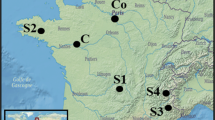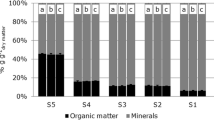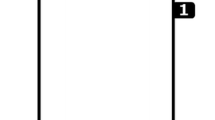Abstract
Purpose
Fine sediments accumulate upstream of hydroelectric dams. To ensure that dams can operate properly, most sediments are returned downstream reaches, but a portion of them have to be dredged and land managed. In parallel, using topsoil from agricultural parcels for urban greening is currently controversial because arable surface areas are decreasing. An alternative idea for protecting these natural resources consists in reusing fine dredged sediment to construct functional soils. The agronomical use of fine dredged sediment raises the question of its ability to provide acceptable physical properties for plant growth.
Materials and methods
Six dredged sediments with contrasted initial agronomical properties were mixed or not with green waste compost and submitted or not to drying-wetting cycles in a 105-day-long experiment under greenhouse conditions. The sediments were analyzed for their capacity to generate stable aggregates. We measured the proportion of macro aggregates > 2 mm with dry-sieved aggregate (DSA) fraction and the > 0.25 mm water-stable aggregate (WSA) fraction for each treatment over time. We also assessed the main sediment physicochemical properties, microbial biomass carbon, and carbon mineralization potential.
Results and discussion
Compost addition (40% in volume) enhanced the WSA fraction of the low-organic-matter-content sediments (< 30 g kg−1), whereas it had a non-significant effect in the other sediments. Multiple linear regressions highlighted a determining role of organic matter in the WSA fraction. At this scale of aggregation, organic matter seemed to mainly interact with clay in an acidic context. Compost addition had either no significant effect or a negative effect on the DSA fraction. Multiple linear regressions suggested that organic matter was not clearly involved in DSA formation in the sediment, whereas macro-porosity was. The first drying-wetting cycles enhanced the DSA proportion of the sediments, but the following cycles had a negative effect. We suggest that disaggregating mechanisms gradually predominated over aggregating mechanisms over time.
Conclusions
All sediments showed acceptable physicochemical properties for plant growth. WSA formation in low-organic-matter-content sediments was improved by adding compost. Drying-wetting cycles had a controversial effect on DSA formation, and only the very first cycles had a beneficial effect on macro-aggregation. The mechanisms involved in aggregation and aggregate stability in soil constructed from sediments seem to be similar to those involved in natural soils. That is why we propose that the soil hierarchical aggregation model initially developed for natural and cultivated soils could be adapted to sediments.





Similar content being viewed by others
References
Abiven S, Menasseri S, Angers DA, Leterme P (2007) Dynamics of aggregate stability and biological binding agents during decomposition of organic materials. Eur J Soil Sci 58(1):239–247. https://doi.org/10.1111/j.1365-2389.2006.00833.x
Anger (2014) Caractérisation des sédiments fins des retenues hydroélectriques en vue d’une orientation vers des filières de valorisation matière. Dissertation, University of Caen
AFNOR (1995a) Qualité du sol – Dosage du phosphore – dosage spectrométrique du phosphore soluble dans une solution d’hydrogénocarbonates de sodium. NF ISO 11263
AFNOR (1995b) Qualité du sol - Détermination de la conductivité électrique spécifique. NF ISO 11265
AFNOR (1998) Qualité du sol - Détermination de la teneur totale en azote par combustion sèche. NF ISO 13878
AFNOR (1999) Qualité des sols - Méthodes chimiques - Détermination de la capacité d'échange cationique (CEC) et des cations extractibles. NF X31–130
AFNOR (2002) Qualité du sol – Détermination des cations Ca2+, Mg2+, K+, Na+ extractibles par l’acétate d’ammonium -Méthode par agitation. NF X31–108
AFNOR (2003a) Qualité du sol - Détermination de la distribution granulométrique des particules du sol - Méthode à la pipette. NF X31–107
AFNOR (2003b) Qualité des sols - Détermination du cuivre, du fer, du manganèse et du zinc - Extraction par l'acétate d'ammonium en présence d'EDTA. NF X31–120
AFNOR (2005) Qualité du sol - Détermination du pH. NF ISO 10390
AFNOR (2006) Amendements organiques - dénominations, spécifications et marquage. NF U44–051
AFNOR (2014) Qualité du sol - Détermination de la teneur en carbonate - Méthode volumétrique. NF ISO 10693
Amézketa E (1999) Soil aggregate stability: a review. J Sustain Agr 14(2–3):83–151. https://doi.org/10.1300/J064v14n02_08
Annabi (2005) Aggregate stabilization in a loamy soil after urban compost addition: relation with compost organic matter characteristics. Dissertation, Institut National Agronomique Paris-Grignon
Arshad MA, Coen GM (1992) Characterization of soil quality: physical and chemical criteria. Am J Altern Agr 7(1-2):25–32. https://doi.org/10.1017/S0889189300004410
Bacholle C, Leclerc B, Coppin Y (2006) Utilisation des produits organiques en reconstitution de sol. Inventaire des pratiques en France. Etat de l’art des connaissances liées aux impacts de ces pratiques, ADEME, Angers, France
Blake GR (1965) Particle density. In: Black CA (ed) Methods of soil analysis: part 1: physical and mineralogical properties, including statistics of measurement and sampling. American Society of Agronomy, Madison, pp 371–373
Bronick CJ, Lal R (2005) Soil structure and management: a review. Geoderma 124:3–22
Calvet R (2003) Le sol: propriétés et fonctions: Tome 1 Constitution et structure, phénomènes aux interfaces. France agricole, Dunod, Paris
Cannavo P, Vidal-Beaudet L, Grosbellet C (2014) Prediction of long-term sustainability of constructed urban soil: impact of high amounts of organic matter on soil physical properties and water transfer. Soil Use Manag 30:272–284
CEN (1999) EN 13040. Soil improvers and growing media. Sample preparation for chemical and physical tests, determination of dry matter content, moisture content and laboratory compacted bulk density. European Committee for Standardization, Bruxelles, Belgium
Chaussod R, Zuvia M, Breuil M-C, Hetier J-M (1992) Biomasse microbienne et “statut organique” des sols tropicaux: exemple d’un sol vénézuélien des Llanos sous différents systèmes de culture. Cahiers ORSTOM. Série Pédologique 27:59–67
Chenu C (1995) Extracellular polysaccharides: an interface between microorganisms and soil constituents. In: Huang PM (ed) Environmental impact of soil component interactions. Natural and anthropogenics organics. Lewis publishers, CRC Press, Boca Raton, pp 217–228
Collins HP, Paul EA, Paustian K, Elliott ET (1997) Characterisation of soil organic matter relative to its stability and turnover. In: Paul EA, Paustian K, Elliott EA, Cole CV (eds) Soil organic matter in temperate agroecosystems: long-term experiments in North America. CRC Press, Boca Raton, pp 51–72
Cosentino D, Chenu C, Le Bissonnais Y (2006) Aggregate stability and microbial community dynamics under drying-wetting cycles in a silt loam soil. Soil Biol Biochem 38:2053–2062
Damas O, Coulon A (2016) Créer des sols fertiles: du déchet à la végétalisation urbaine. Le moniteur, Antony
Daniels WL, Whittecar GR, Carter III CH (2007) Conversion of Potomac River dredge sediments to productive agricultural soils. The 2007 National Meeting of the American Society of Mining and Reclamation, pp 183-199
De Boodt M, Verdonck O, Cappaert J (1974) Methods for measuring the water release curve of organic substrates. Acta Hortic 37:2054–2062
De Gryze S, Six J, Brits C, Merckx R (2005) A quantification of short-term macroaggregate dynamics: influences of wheat residue input and texture. Soil Biol Biochem 37(1):55–66. https://doi.org/10.1016/j.soilbio.2004.07.024
Denef K, Six J, Bossuyt H, Frey SD, Elliott ET, Merckx R, Paustian K (2001) Influence of dry-wet cycles on the interrelationship between aggregate, particulate organic matter, and microbial community dynamics. Soil Biol Biochem 33(12-13):1599–1611. https://doi.org/10.1016/S0038-0717(01)00076-1
Dexter AR (1988) Advances in characterization of soil structure. Soil Till Res 11(3-4):199–283. https://doi.org/10.1016/0167-1987(88)90002-5
Francou (2003) Stabilisation de la matière organique au cours du compostage de déchets urbains: influence de la nature des déchets et du procédé de compostage-recherche d’indicateurs pertinents. Dissertation, Institut National Agronomique Paris-Grignon
Grosbellet C, Vidal-Beaudet L, Caubel V, Charpentier S (2011) Improvement of soil structure formation by fractionation of coarse organic matter. Geoderma 162(1-2):27–38. https://doi.org/10.1016/j.geoderma.2011.01.003
Gualtieri AF, Guagliardi A, Iseppi A (2004) The quantitative determination of the crystalline and amorphous content by the Rietveld method: application to glass ceramics with different adsorption coefficient. In: Mittemeijer EJ, Scardi P (eds) Diffraction analysis of the microstructure of materials. Springer, Berlin, pp 147–166
Haus NW (2011) Beneficial reuse of dredged materials in upland environments. Master of Science in crop & soil environment sciences, Virginia Polytechnic Institute
Haynes R, Swift R (1990) Stability of soil aggregates on relation to organic constituents and soil water content. J Soil Sci 41(1):73–83. https://doi.org/10.1111/j.1365-2389.1990.tb00046.x
INERIS (2010) Qualité chimique des sédiments fluviaux en France: Synthèse des bases de données disponibles. Rapport d'étude n°INERIS-DRC-10-105335-04971A
IUSS Working Group WRB (2015) World Reference Base for Soil Resources 2014, update 2015 International soil classification system for naming soils and creating legends for soil maps. World Soil Resources Reports No 106. FAO, Rome
Jastrow JD (1995) Soil aggregate formation and the accrual of particulated and mineral-associated organic matter. Soil Biol Biochem 28:665–676
JORF (2008) Arrêté du 30/05/08 fixant les prescriptions générales applicables aux opérations d’entretien de cours d’eau ou canaux soumis à autorisation ou à déclaration en application des articles L. 214-1 à L. 214-6 du code de l’environnement et relevant de la rubrique 3.2.1.0 de la nomenclature annexée au tableau de l’article R. 214-1 du code de l’environnement. Journal Officiel de la République Française n° 147 du 25 juin 2008
Kay BD (1998) Soil structure and organic carbon: a review. In: Bronick CJ, Lal R (2004) Soil structure and management: a review. Geoderma 124:3–22
Kemper WD, Rosenau RC, Dexter AR (1987) Cohesion development in disrupted soils as affected by clay and organic matter content and temperature. Soil Sci Soc Am J 51(4):860–866. https://doi.org/10.2136/sssaj1987.03615995005100040004x
Kim DJ, Feyen J, Vereecken H (1993) Prediction of dynamic hydraulic properties in ripening soil. Geoderma 57:231–246
Koropchak SC, Daniels WL, Wick A, Whittecar GR, Haus N (2016) Beneficial use of dredge materials for soil reconstruction and development of dredge screening protocols. J Environ Qual 45(1):62–73. https://doi.org/10.2134/jeq2014.12.0529
Le Bisonnais Y (2016) Aggregate stability and assessment of soil crustability and erodibility: I. Theory and methodology. Eur J Soil Sci 67:1–20
Le Bissonnais Y, Cros-Cayot S, Gascuel-Odoux C (2002) Topographic variation of aggregate stability at field scale: effect on runoff and erosion. Agronomie 22:489–501
Le Bissonnais Y, Le Souder C (1995) Mesurer la stabilité structurale des sols pour évaluer leur sensibilité à la battance et à l’érosion. Etude et Gestion des Sols 2:43–55
Lê S, Josse J, Husson F (2008) FactoMineR: an R package for multivariate analysis. J Stat Softw 25:1–18
Levy GJ, Torrento JR (1995) Clay dispersion and macroaggregate stability as affected by exchangeable potassium and sodium. Soil Sci 160(5):352–358. https://doi.org/10.1097/00010694-199511000-00004
Macia P, Fernandez-Costas C, Rodriguez E, Sieiro P, Pazos M, Sanroman MA (2014) Technosols as a novel valorization strategy for an ecological of dredged marine sediments. Ecol Eng 67:182–189
Morel R (1996) Les sols cultivés. Lavoisier/TEC et DOC, Paris
Oliveira BRF, van Laarhoven K, Smit MPJ, Rijnaarts HHM, Grotenhuis T (2017) Impact of compost and manure on the ripening of dredged sediments. J Soils Sediments 17(2):567–577. https://doi.org/10.1007/s11368-016-1571-6
Pagliai M, Vignozzi N (2002) Soil pore system as an indicator of soil quality. In: Pagliai M, Jones R (eds) Sustainable soil management for environmental protection. Soil physics aspects. Catena, Reiskirchen, pp 71–82
Pons LJ, Zonneveld IS (1965) Soil ripening and soil classification. Initial soil formation in alluvial deposits and a classification of the resulting soils, Publication 13, International Institute for Land Reclamation and Improvement
Quirk JP, Schofield RK (1955) The effect of electrolyte concentration on soil permeability. J Soil Sci 6:165–178
R Core Team (2015) R: a language and environment for statistical computing. R Foundation for Statistical Computing. http://www.R-project.org
Regelink IC, Stoof CR, Rousseva S, Weng L, Lair GJ, Kram P, Nikolaidis N, Kercheva P, Banwart M, Comans S, Comans RNJ (2015) Linkages between aggregate formation, porosity and soil chemical properties. Geoderma 248:24–37
Richards LA (1947) Pressure membrane apparatus: construction and use. Agric Eng 28:451–454
Robert M, Chenu C (1992) Interactions between microorganisms and soil minerals. In: Stotzky G, Bollag JM (eds) Soil biochemistry. Marcel Dekker, New York, pp 4–29
Schumacher BA, Shines KC, Burton JV, Papp ML (1991) A comparison of soil sample homogenization techniques (chapter 4) In Simmons MS (ed) Hazardous waste measurements. Lewis publishers Inc, Chelsea, pp 53–68
Séré G, Ouvrard S, Schwartz C, Renat JC, Morel JL (2008) Soil construction: a step for ecological reclamation of derelict lands. J Soils Sediments 8(2):130–136. https://doi.org/10.1065/jss2008.03.277
Sheehan C, Harrington J, Murphy JD (2010) A technical assessment of topsoil production from dredged material. Resour Conserv Recycl 54:1377–1385
Six J, Paustian K, Elliott ET, Combrick C (2000) Soil structure and organic matter: I. Distribution aggregate-size classes and aggregate-associated carbon. Soil Sci Soc Am J 64:681–689
Sturgis TC, Lee CR, Banks HC (2001a) Evaluation of Toledo Harbor for manufactured soil. US Army Corps of Engineers, Environmental Laboratory
Sturgis TC, Lee CR, Banks HC, Burchell MR, Johnson K (2001b) Evaluation of manufactured soil using dredged material from New York/New Jersey Harbor Newton Creek site. US Army Corps of Engineers, Environmental Laboratory
Tisdall JM, Oades JM (1982) Organic matter and water-stable aggregates in soils. J Soil Sci 33(2):141–163. https://doi.org/10.1111/j.1365-2389.1982.tb01755.x
UNEP (1999) Le sol support de nos plantations. du Paysage, Union Nationale des Entreprises
Utomo WH, Dexter AR (1982) Changes in soil aggregate water stability induced by wetting and drying cycles in non-saturated soil. J Soil Sci 33(4):623–637. https://doi.org/10.1111/j.1365-2389.1982.tb01794.x
Vance ED, Brookes PC, Jenkison DS (1987) An extraction method for measuring soil microbial biomass C. Soil Biol Biochem 19(6):703–707. https://doi.org/10.1016/0038-0717(87)90052-6
Vermeulen J, Grotenhuis T, Joziasse J, Rulkens W (2003) Ripening of clayed dredged sediments during temporary upland disposal: a bioremediation technique. J Soils Sediments 3:49–59
Vidal-Beaudet L, Grosbellet C, Forget-Caubel V, Charpentier S (2012) Modelling long-term carbon dynamics in soils reconstituted with high quantities of organic matter. Eur J Soil Sci 63(6):787–797. https://doi.org/10.1111/j.1365-2389.2012.01494.x
Wallenstein MD, Mcnulty S, Fernandez IJ, Boggs J, Schlesinger WH (2006) Nitrogen fertilization decreases forest soil fungal and bacterial biomass in three long-term experiments. For Ecol Manag 222:459–468
Acknowledgments
We wish to thank Nadège Blon (engineer in the chemistry department—University of Angers), and Claudie Mazzega and Yvette Barraud-Roussel (technicians in the Environnement Physique de la Plante Horticole (EPHor) unit—Agrocampus-Ouest) for their help in laboratory work, and Sébastien Menu (engineer in Development Direction—Division Production Ingénierie Hydraulique (DPIH)—Electricité de France (EDF)) for his advice and his revision of the manuscript. Experiments were conducted at the ImHorPhen (shared experimental facilities) with the assistance of R. Gardet
Author information
Authors and Affiliations
Corresponding author
Additional information
Responsible editor: Marc Babut
Rights and permissions
About this article
Cite this article
Fourvel, G., Vidal-Beaudet, L., Le Bocq, A. et al. Early structural stability of fine dam sediment in soil construction. J Soils Sediments 18, 2647–2663 (2018). https://doi.org/10.1007/s11368-018-1926-2
Received:
Accepted:
Published:
Issue Date:
DOI: https://doi.org/10.1007/s11368-018-1926-2




